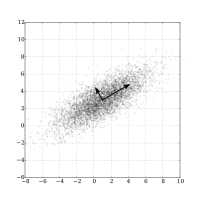
Photo from wikipedia
Abstract Position based visual servoing is a widely adopted tool in robotics and automation. While the extended Kalman filter (EKF) has been proposed as an effective technique for this, it… Click to show full abstract
Abstract Position based visual servoing is a widely adopted tool in robotics and automation. While the extended Kalman filter (EKF) has been proposed as an effective technique for this, it requires accurate noise covariance matrices to render desirable performance. Although numerous techniques for updating or estimating the covariance matrices have been developed in the literature, many of these suffer from computational limits or difficulties in imposing structural constraints such as positive semi-definiteness (PSD). In this paper, a relatively new framework, namely the autocovariance least-squares (ALS) method, is applied to estimate noise covariances using real world visual servoing data. To generate the innovations data required for the ALS method, we utilize standard position based visual servoing methods such as EKF, and also an advanced optimization-based framework, namely moving horizon estimation (MHE). A major advantage of the proposed method is that the PSD and other structural constraints on the noise covariances can be enforced conveniently in the optimization problem, which can be solved efficiently using existing software packages. Our results show that using the ALS estimated covariances in the EKF, instead of hand-tuned covariances, gives more than 20% mean error reduction in visual servoing, while utilising MHE to generate the ALS innovations provides a further 21% accuracy improvement.
Journal Title: Mechatronics
Year Published: 2020
Link to full text (if available)
Share on Social Media: Sign Up to like & get
recommendations!